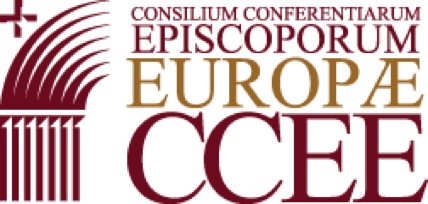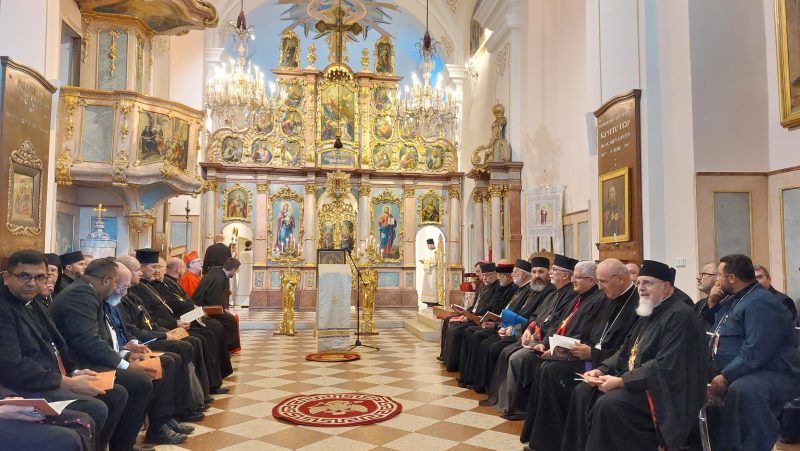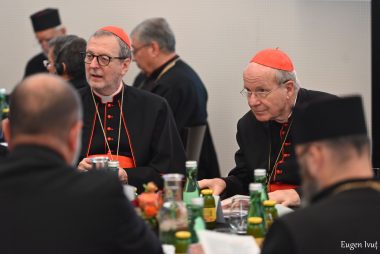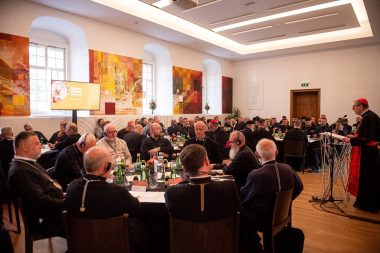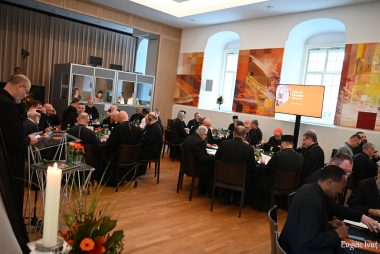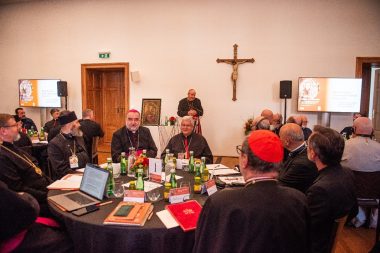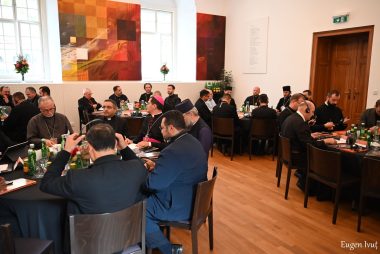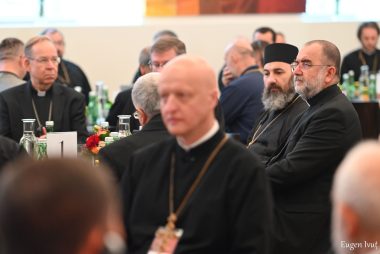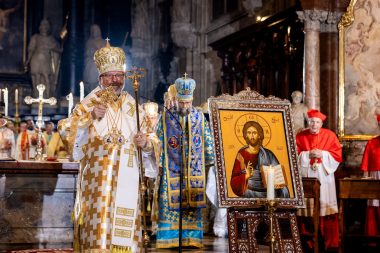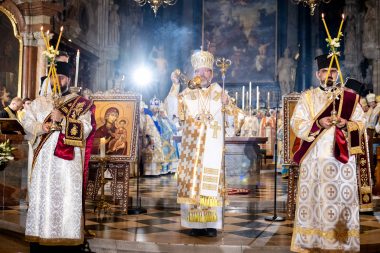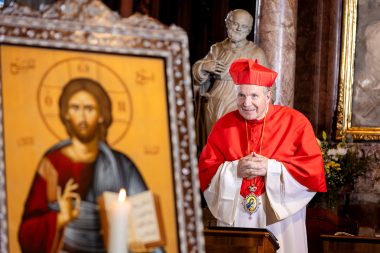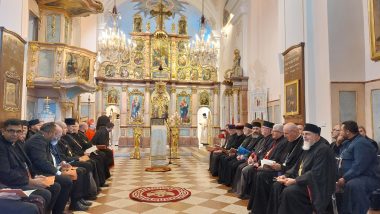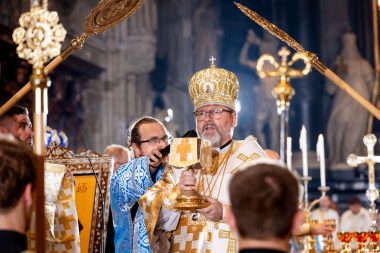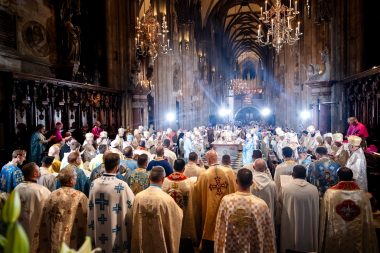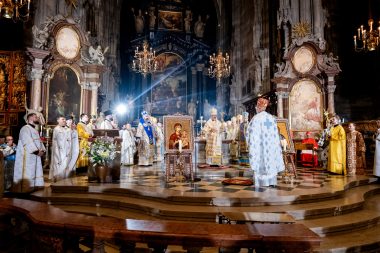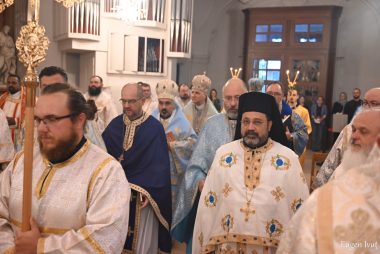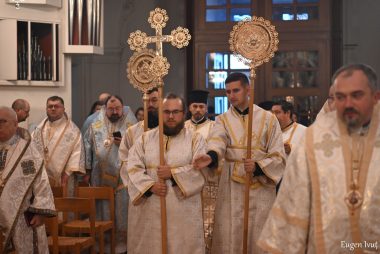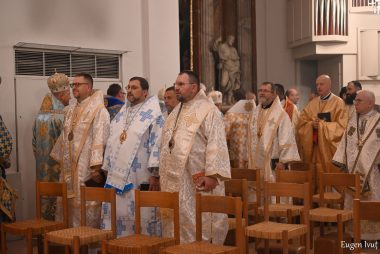The 26th Assembly of the Eastern Catholic Bishops of Europe took place in Vienna from 8 to 11 September 2025, bringing together over 65 bishops and more than 100 representatives of the Eastern Catholic Churches. The meeting, organized under the auspices of the Council of the European Bishops’ Conferences (CCEE) at the invitation of Cardinal Christoph Schönborn, Ordinary for the Eastern Catholic Faithful in Austria, was held on the 250th anniversary of the “Barbareum”, the Greek Catholic seminary founded in Vienna by Empress Maria Theresia.
Among the participants were Cardinal Claudio Gugerotti, Prefect of the Dicastery for Eastern Churches, Archbishop Gintaras Grušas, President of the CCEE, and Archbishop Pedro López Quintana, Apostolic Nuncio to Austria. Also present were the heads of several Eastern Catholic Churches, including Major Archbishop Sviatoslav Shevchuk (Ukrainian Greek-Catholic Church), Archbishop Jonáš Maxim (Slovak Greek-Catholic Church), and Archbishop Fülöp Kocsis (Hungarian Greek-Catholic Church).
Unity in Diversity: The Three Pillars of Communion
With the aim of strengthening communion among the various components of the Catholic Church in Europe, the overarching theme “Unity in Diversity” was developed in three working sessions according to the three dimensions of ecclesial communion in Europe: communion with the Bishop of Rome; that of the Eastern Catholic Churches sui iurisamong each other; and that of the Eastern Catholics with the Latin Rite Church.
- The first working session was introduced by Cardinal Gugerotti. In his presentation, the Cardinal Prefect offered an interpretative approach that goes beyond the repetition of good thoughts on unity, and also highlights the constant “symphonic” dynamism that should animate the two poles: unity and diversity, that is, universality (of the One Catholic Church) and specificity (of each of the sui iuris Churches). This dynamic relationship is not without problems and conflicts, both at the jurisdictional level and at the cultural, political, and economic levels. In exemplifying some of these issues, the Cardinal Prefect illustrated the Holy See’s commitment to supporting the desired harmony.
- The second theme, communion among the Eastern Catholic Churches in Europe, was addressed by Archbishop Grušas, President of the CCEE, who highlighted in his speech the gift, and commitment, that this communion entails, emphasizing the esteem and appreciation with which the Eastern Catholic Churches are regarded, and the many lessons they can and must offer to the universal Church in an increasingly secularized Europe. They are invited to value their experience as the “leaven” that ferments the dough and makes it grow from within. Recalling the CCEE’s ongoing historical commitment to the annual meeting of the Eastern Catholic Bishops of Europe, the President reiterated the importance of the active sharing experienced in these meetings, with a particular focus on the implementation phase of the Synod on Synodality, in which Eastern Catholics have much to offer, starting from their rich experience of episcopal synodality-collegiality, as well as creative balancing between the various ecclesial bodies of participation.
- Describing the establishment of the first Ordinariate for Eastern Catholics in Vienna in 1935 as a “provisional structure” to assist migrant faithful, Cardinal Schönborn, in his discourse on the communion of Eastern Catholics with the Latin Rite Church, highlighted the importance of Ordinariates as a constructive way to protect, on the one hand, the specificity of each of the sui iuris Churches in a territory of Latin jurisdiction, and on the other, to overcome the difficulties that a second hierarchy would raise in overlapping territories. The Cardinal illustrated the rich experience of the Austrian Ordinariate, which has grown significantly over the past 20 years and now comprises 43 Eastern communities, welcomed, not only in the Archdiocese of Vienna, but also throughout Austria with the support of the Austrian Bishops’ Conference, both in administrative terms (baptismal and marriage registers) and financially (support of clerics, especially those who are married, to achieve equal treatment with Latin Rite clergy). The close and cordial relationship between the Ordinary and the apostolic visitors and the heads of the sui iuris Churches is a fundamental element for a stronger communion between the Eastern Catholic Churches and the Latin Rite Church in Europe.
The assembly once again took place in the sad context of the war in Ukraine. This awareness was emphasized in the presentation of Major Archbishop Shevchuk, who also expressed his sincere thanks for the support and the assistance received, both from the Churches and from civil authorities. There was also no shortage of thought and attention to other ongoing conflicts affecting our sui iuris Churches around the world.
The group discussions culminated in a plenary discussion, during which the participants expressed their desire to work more closely on the following proposals:
- A more accurate representation of the youth from the sui iuris Churches at World Youth Days, as well as in more regular local meetings, both in person and within the digital world.
- A more attentive training in the educational programs of clergy, especially those of the Latin rite, aimed at understanding other traditions, and accompanied by a concrete exchange of experiences. It is hoped that the outcome will be a more coordinated promotion of knowledge of the Eastern Catholic world.
- An acceleration in the publication of canonical documents pertaining, among other things, to the membership of the faithful in their respective sui iuris Churches, which takes place in a juridical and ritual-pastoral sense, as well as in connection with the central government.
- An understanding of the new sensitivity to bi-ritualism and adaptation to the rite, now narrower than in the past, and with an emphasis on the primacy of caring for one’s rite of origin.
- An attention to the support of clerics of sui iuris Churches engaged in bi-ritualism in the contexts of diaspora.
- A greater discernment in ecumenical relations with the Orthodox Churches regarding the validity of the Sacraments and the recognition of Apostolic succession.
- A hope for an effective and efficient follow-up to the work initiated in the annual assemblies, through an appropriate structure for managing the documents and actions undertaken.
Highlights of the Program
In addition to the working sessions, the program was enriched by moments that strengthened ties between the participants and with the institutions.
- Of primary importance were the liturgical celebrations in the various rites: the Akathistos hymn in various languages; the Holy Qurbana in the Syro-Malabar Rite; and the Divine Liturgy of St. John Chrysostom, the latter having also been celebrated in St. Stephen’s Cathedral, a unique event in the history of the Church in Austria, with the presence of 60 Eastern bishops. The event attracted the attention of national media, which chose to broadcast it live.
- Relations with civil institutions were also fostered, with the Mayor of Vienna, Dr. Michael Ludwig, who invited the participants to a luncheon in the prestigious Stadtsenatssitzungssaal at the Vienna City Hall. Equally significant was the meeting at the Archbishop’s Palace with the Representative of the European Union Commission in Austria, Patrick Lobis, and Federal Minister Claudia Plakolm, where the dialogue focused on the mutual expectations between the Church and civil institutions for the future of Europe.
- Participants were welcomed by the Apostolic Nuncio to Austria, Archbishop Pedro López Quintana, in the historic nunciature building. They then visited Klosterneuburg Abbey, where they were able to appreciate the history and spirituality of the place, as well as a dinner under the auspices of Abbot Anton Höslinger, CanReg.
- The concluding session included a presentation by Professor Dr. Dr. Thomas Mark Németh on the history and presence of the Eastern Catholic Churches in Austria.
The next Assembly of the Bishops of the Eastern Catholic Churches of Europe is scheduled from 15 to 18 September 2026, in Máriapócs, Hungary. The meeting will focus on topics related to missionary formation in the Eastern Catholic Churches sui iuris through catechisms, mystagogy, and the transmission of the faith, as well as the strengthening of Eastern identity within the diaspora.
Photo: Eugen Ivut
